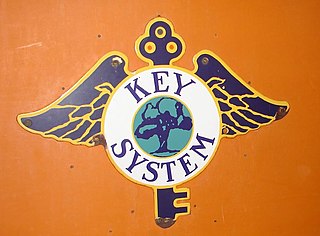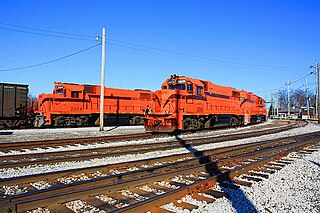
The Pacific Electric Railway Company, nicknamed the Red Cars, was a privately owned mass transit system in Southern California consisting of electrically powered streetcars, interurban cars, and buses and was the largest electric railway system in the world in the 1920s. Organized around the city centers of Los Angeles and San Bernardino, it connected cities in Los Angeles County, Orange County, San Bernardino County and Riverside County.

The Interurban is a type of electric railway, with streetcar-like electric self-propelled rail cars which run within and between cities or towns. They were very prevalent in North America between 1900 and 1925 and were used primarily for passenger travel between cities and their surrounding suburban and rural communities. The concept spread to countries such as Japan, the Netherlands, Switzerland, Belgium, Italy and Poland. Interurban as a term encompassed the companies, their infrastructure, their cars that ran on the rails, and their service. In the United States, the early 1900s interurban was a valuable economic institution. Most roads between towns and many town streets were unpaved. Transportation and haulage was by horse-drawn carriages and carts. The interurban provided reliable transportation, particularly in winter weather, between the town and countryside. In 1915, 15,500 miles (24,900 km) of interurban railways were operating in the United States and, for a few years, interurban railways, including the numerous manufacturers of cars and equipment, were the fifth-largest industry in the country. By 1930, most interurbans in North America were gone with a few surviving into the 1950s.

The Key System was a privately owned company that provided mass transit in the cities of Oakland, Berkeley, Alameda, Emeryville, Piedmont, San Leandro, Richmond, Albany, and El Cerrito in the eastern San Francisco Bay Area from 1903 until 1960, when it was sold to a newly formed public agency, AC Transit. The Key System consisted of local streetcar and bus lines in the East Bay, and commuter rail and bus lines connecting the East Bay to San Francisco by a ferry pier on San Francisco Bay, later via the lower deck of the Bay Bridge. At its height during the 1940s, the Key System had over 66 miles (106 km) of track. The local streetcars were discontinued in 1948 and the commuter trains to San Francisco were discontinued in 1958. The Key System's territory is today served by BART and AC Transit bus service.

The Chicago South Shore and South Bend Railroad, also known as the South Shore Line, is a Class III freight railroad operating between Chicago, Illinois, and South Bend, Indiana. The railroad serves as a link between Class I railroads and local industries in northeast Illinois and northwest Indiana. It built the South Shore Line electric interurban and operated it until 1990, when it transferred to the Northern Indiana Commuter Transportation District. The railroad is owned by the Anacostia Rail Holdings Company.

The Illinois Terminal Railroad Company, known as the Illinois Traction System until 1937, was a heavy duty interurban electric railroad with extensive passenger and freight business in central and southern Illinois from 1896 to 1956. When Depression era Illinois Traction was in financial distress and had to reorganize, the Illinois Terminal name was adopted to reflect the line's primary money making role as a freight interchange link to major steam railroads at its terminal ends, Peoria, Danville, and St. Louis. Interurban passenger service slowly was reduced, ending in 1956. Freight operation continued but was hobbled by tight street running in some towns requiring very sharp radius turns. In 1956, ITC was absorbed by a consortium of connecting railroads.

The Market Street Railway Company was a commercial streetcar and bus operator in San Francisco. The company was named after the famous Market Street of that city, which formed the core of its transportation network. Over the years, the company was also known as the Market Street Railroad Company, the Market Street Cable Railway Company and the United Railroads of San Francisco. Once the largest transit operator in the city, the company folded in 1944 and its assets and services were acquired by the city-owned San Francisco Municipal Railway. Many of the former routes continue to exist into the 2020s, but served by buses.

The Iowa Traction Railway Company, formerly the Iowa Traction Railroad Company, is a shortline railroad operating in the United States as a common carrier. It was originally founded in 1896 as the Mason City and Clear Lake Railway, a passenger carrier. Business has been exclusively freight since 1937. One of the only remaining freight railroads in the United States to use electric locomotives, the company's main line connects Mason City and Clear Lake, Iowa. The railroad also serves Rorick Park near Mason City.

The Central California Traction Company is a Class III short-line railroad operating in the northern San Joaquin Valley, in San Joaquin County, California. It is owned jointly by the Union Pacific and BNSF Railway.

The Sacramento Northern Railway was a 183-mile (295 km) electric interurban railway that connected Chico in northern California with Oakland via the California capital, Sacramento. In its operation it ran directly on the streets of Oakland, Sacramento, Yuba City, Chico, and Woodland and ran interurban passenger service until 1941 and freight service into the 1960s.

The Tidewater Southern Railway was a short line railroad in Central California in the United States. For most of its history, it was a subsidiary of the Western Pacific Railroad. It was originally built as an interurban system, connecting to the Central California Traction Company, Western Pacific Railroad, Southern Pacific Railroad and Atchison, Topeka and Santa Fe Railway in Stockton, California. Its mainline went southeast from Stockton to Escalon, California and thence to Modesto, California before splitting into two branches ending at the towns of Turlock and Hilmar. Until the mid-1930s, there were plans to extend the line to Fresno and even toward the Los Angeles area. Today, much of the line is still operated by the Union Pacific Railroad. Of all the former interurban railroads in California, the former Tidewater Southern retains the highest percentage of still operating trackage.
OmniTRAX, Inc. is a transportation and transportation infrastructure holding company based in Denver, Colorado, in the United States. It primarily owns or operates railroads, with a network of 25 regional and shortline railroads in 12 U.S. states and three Canadian provinces. It is one of the largest privately owned railroad companies in the United States. The firm also invests in, develops, and operates ports, multimodal transportation terminals, and industrial parks.
The Sand Springs Railway is a class III railroad operating in Oklahoma. It was originally formed in 1911 by industrialist Charles Page to connect his newly formed city of Sand Springs to Tulsa, operating both as a passenger carrying interurban and a freight carrier. At Sand Springs, the company also served his children's home, and Page directed all railroad profits to support the home's operations.

The Terre Haute, Indianapolis and Eastern Traction Company, or THI&E, was the second largest interurban in the U.S. state of Indiana at the 1920s height of the "interurban era." This system included over 400 miles (640 km) of track, with lines radiating from Indianapolis to the east, northwest, west and southwest as well as streetcar lines in several major cities. The THI&E was formed in 1907 by the Schoepf-McGowan Syndicate as a combination of several predecessor interurban and street car companies and was operated independently until incorporation into the Indiana Railroad in 1931. The THI&E served a wide range of territory, including farmlands in central Indiana, the mining region around Brazil, and numerous urban centers. Eventually, it slowly succumbed like all of the other central Indiana interurban lines, to competition from automobiles, trucks, and improved paralleling highways.
Rail transportation is an important element of the transportation network in the U.S. state of Oregon. Rail transportation has existed in Oregon in some form since 1855, and the state was a pioneer in development of electric railway systems. While the automobile has displaced many uses of rail in the state, rail remains a key means of moving passengers and freight, both within the state and to points beyond its borders.
This article lists the railroads and a timeline of railroad history in Solano County, California.












